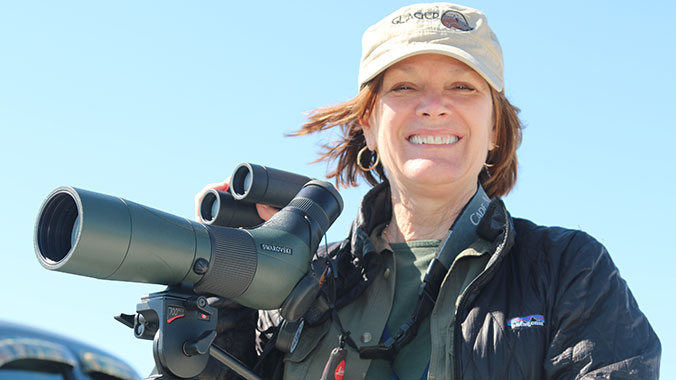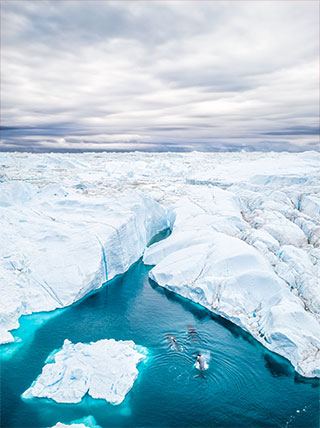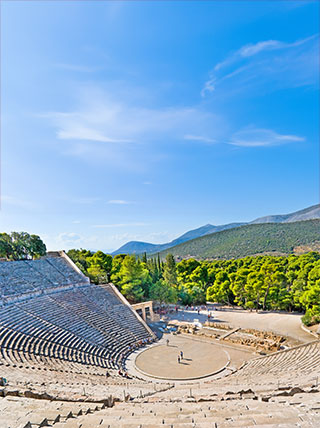Montana
Birding in Glacier National Park
Program No. 22411RJ
Join expert birders for an off-the-beaten path adventure to search for and learn about warblers, loons, woodpeckers and many more bird species that thrive in Glacier National Park.
Enroll with Confidence
We want your Road Scholar learning adventure to be something to look forward to—not worry about. Learn more
Protecting the Environment
We offset a portion of the emissions created by your travel. Learn more
This date is available to book as a private experience for your group!
6 days
5 nights
13 meals
5B 4L 4D
1
Check-in, Orientation, Welcome Dinner
Lake McDonald in West Glacier
2
McDonald Creek & Inside North Fork Road, Presentation
Lake McDonald in West Glacier
3
McDonald Creek Trail, Trail of Cedars, Southern Border GNP
St. Mary, Montana
4
East Side of Glacier National Park, Presentation
St. Mary, Montana
6
Program Concludes
Kalispell
At a Glance
On this off-the-beaten path birding adventure, both novice and skilled birders will hone their birding skills while hiking in Glacier National Park, one of the nation’s most intact and undisturbed ecosystems. Explore eastern, western and alpine habitats with expert local birders who will use both sound and sight to seek out a diverse array of avian species. Enriching stories and lore will help you gain a greater appreciation for the species you encounter. This program will emphasize birding by ear due to thick vegetation, and many birds may be heard and not seen.
Activity Level
Outdoor: Spirited
I enjoy getting my heart going on my bike or on trails. Nothing beats the thrill of taking on a rewarding climb or ride on varied terrain with inclines. Let’s keep moving — occasional stops only, please.

Small Group
Love to learn and explore in a small-group setting? These adventures offer small, personal experiences with groups of 13 to 24 participants.
Best of all, you’ll…
- Benefit from the instruction of some of the top birding experts in the region and develop your birding by ear skills.
- Search for a diversity of species that call Glacier National Park home, such as Harlequin Duck, Black-backed and Three-toed Woodpecker, and Water Ouzel.
- Explore an array of habitats on the west and east side of the continental divide, and learn about the geology, botany, history and wildlife of Glacier National Park.
General Notes
This program will emphasize birding by ear due to thick vegetation, and many birds may be heard and not seen. All Road Scholar birding programs have a maximum participant-to-instructor ratio of 14:1 in the field. We adhere to the American Birding Association’s Code of Ethics. Learn more at http://www.aba.org/about/ethics.html
Suggested Reading List
(7 books)
Visit the Road Scholar Bookshop
You can find many of the books we recommend at the Road Scholar store on bookshop.org, a website that supports local bookstores.
Birding in Glacier National Park
Program Number: 22411
Montana Bird Distribution
The long awaited, newly revised, 7th edition of P.D. Skaar’s Montana Bird Distribution is available. This book is an excellent companion to field guides because it indicates where birds are found in Montana. It is a book of maps: for all of Montana's 427 bird species observed in the state, maps show breeding and wintering areas.
Eighteen birds are new to the new edition: Cackling Goose (a split from Canada Goose), Tufted Duck, Manx Shearwater, Glossy Ibis, White-tailed Kite, Crested Caracara, Ross’s Gull, Iceland Gull, Lesser Black-backed Gull, Long-billed Murrelet (a split from Ancient Murrelet), Inca Dove, Carolina Wren, Pacific Wren (a split from Winter Wren), Curve-billed Thrasher, Siberian Accentor, Blue-winged Warbler, Eastern Towhee, and Eastern Meadowlark.
Birds In Place: a Habitat-based Field Guide to Birds of the Northern Rockies
Radd Icenoggle is a native Montanan, who has spent a lifetime as an outdoors and wildlife enthusiast. He possesses a degree in biology with an emphasis on habitat relations. During his studies, he wrote a thesis that explored the effects of slope aspect on communities in southwestern Montana and, more specifically, the ways that Clark's Nutcrackers use their habitat. He has worked for the U.S. Forest Service as a botanist, bird biologist, and hydrology technician. Through his writing and photography, he endeavors to bring nature to his audience.
This habitat-based guide is written for both novice and long-time birders to use in the Northern Rockies. Color photographs illustrate the species and graphics supply information on seasons, migration, residents.
Text includes physical description, mating, nesting and fledging behaviors, and especially in what type of domain to seek each species.
Exploring Glacier National Park
Glacier National Park in northern Montana offers visitors the chance to be immersed in a pristine landscape, and an opportunity to experience the Rocky Mountain West in all its unspoiled glory. Author and naturalist David Rockwell explains the evolution of the park's geology from the erosion of mountains more than a billion years ago to the glaciers that gave Glacier National Park its distinctive landscape. He explores the natural history of the plants and animals of the park's six distinct regions.
Wildflowers of Glacier National Park
Wildflowers of Glacier National park and Surrounding Areas is a user-friendly guide featuring over 300 of Glacier National Park's most common plant species. From wildflowers to trees to grasses and sedges, this book features beautiful photographs, detailed descriptions, notes on habitat and fun facts for each plant. It's a perfect plant reference for anyone with an interest in the natural history and splendor of Glacier National Park.
The index lists plants both by their common and scientific names.
The Birder's Guide to Montana
Your comprehensive guide on where to find Montana's birds.
Includes detailed descriptions of over forty-five major birding areas, maps, black and white photos, illustrations and much more.
eBird Pro 7, iBird Pro
Handheld Field Guide to birds of North America for iPhone, iPod Touch, iPad, Android, Kindle and Windows 8 with powerful decision engine. These programs include bird songs, checklists and GPS locators. If you have a smartphone or pad, these are highly recommended.
The Sibley Guide to Birds
David Allen Sibley, America's most gifted contemporary painter of birds, is the author and illustrator of this comprehensive guide. His beautifully detailed illustrations—more than 6,600 in all—and descriptions of 810 species and 350 regional populations will enrich every birder's experience.
The Sibley Guide's innovative design makes it entirely user friendly. The illustrations are arranged to facilitate comparison, yet still capture the unique character of each species.
The Sibley Guide to Birds provides a wealth of new information:
—Captioned illustrations show many previously unpublished field marks and revisions of known marks
—Nearly every species is shown in flight
—Measurements include length, wingspan, and weight for every species
—Subspecies and geographic variants are covered thoroughly
—Complete voice descriptions are included for every species
—Maps show the complete distribution of every species: summer and winter ranges, migration routes, and rare occurrences
Both novice and experienced birders will appreciate these and other innovative features:
—An introductory page for each family or group of related families makes comparisons simple
—Clear and concise labels with pointers identify field marks directly
—Birds are illustrated in similar poses to make comparisons between species quick and easy
—Illustrations emphasize the way birds look in the field
With The Sibley Guide to Birds, the National Audubon Society makes the art and expertise of David Sibley available to the world in a comprehensive, handsome, easy-to-use volume that will be the indispensable identification guide every birder must own.
Program
At a Glance
Duration
6 days
Program Begins
Lake McDonald in West Glacier
Program Concludes
Kalispell
Group Type
Small Group
Meals
13
| 5B |
4L |
4D |
Activity Level
On this off-the-beaten path birding adventure, both novice and skilled birders will hone their birding skills while hiking in Glacier National Park, one of the nation’s most intact and undisturbed ecosystems. Explore eastern, western and alpine habitats with expert local birders who will use both sound and sight to seek out a diverse array of avian species. Enriching stories and lore will help you gain a greater appreciation for the species you encounter. This program will emphasize birding by ear due to thick vegetation, and many birds may be heard and not seen.)
Best of all, you'll...
- Benefit from the instruction of some of the top birding experts in the region and develop your birding by ear skills.
- Search for a diversity of species that call Glacier National Park home, such as Harlequin Duck, Black-backed and Three-toed Woodpecker, and Water Ouzel.
- Explore an array of habitats on the west and east side of the continental divide, and learn about the geology, botany, history and wildlife of Glacier National Park.
General Notes
This program will emphasize birding by ear due to thick vegetation, and many birds may be heard and not seen. All Road Scholar birding programs have a maximum participant-to-instructor ratio of 14:1 in the field. We adhere to the American Birding Association’s Code of Ethics. Learn more at http://www.aba.org/about/ethics.html
Activity Level
Outdoor: Spirited
I enjoy getting my heart going on my bike or on trails. Nothing beats the thrill of taking on a rewarding climb or ride on varied terrain with inclines. Let’s keep moving — occasional stops only, please.
Small Group
(13 to 24)
Love to learn and explore in a small-group setting? These adventures offer small, personal experiences with groups of 13 to 24 participants.
Suggested Reading List
View Full List
(7 Books)
You can also find many of the books we recommend at the Road Scholar store on bookshop.org, a website that supports local bookstores.
HAVE QUESTIONS?
Prefer to enroll or inquire by phone?
We can help. Give us a call, and we can answer all of your questions!
Call
800-454-5768
While we make every effort to ensure the accuracy of our published materials, programs are typically advertised more than a year prior to their start date. As a result, some program activities, schedules, accommodations, personnel, and other logistics occasionally change due to local conditions or circumstances. Should a major change occur, we will make every effort to alert you. For less significant changes, we will update you during orientation. Thank you for your understanding.
Duration
6 days
5 nights
What's Included
13 meals | 5B | 4L | 4D |
3 expert-led lectures
9 expert-led field trips
An experienced Group Leader
5 nights of accommodations
Taxes and customary gratuity
Road Scholar Assurance Plan
Day
1
Check-in, Orientation, Welcome Dinner
Location:
Lake McDonald in West Glacier
Meals:
D
Stay:
Motel Lake McDonald
Activity Note
Motel check-in available from 4:00 p.m. Remember to bring your nametag (sent previously). Walking 300 yards to dining and meeting room facilities.
Afternoon:
Program Orientation: 4:00 p.m. After you check in and have your room assignment, join us in the auditorium at Lake McDonald Lodge to get any updated information. If you arrive late, please locate your Group Leader and let them know you have arrived. The Group Leader will greet everyone and lead introductions. We will review the up-to-date program schedule, discuss roles and responsibilities, logistics, safety guidelines, emergency procedures, and answer questions. We will ride in 15-passenger vans to trailheads for field trips. Trail selections will be made by Group Leaders each day based on weather, trail conditions, and group ability. Each day, hikers will have a choice between hikes of different levels of difficulty. We will break into hiking groups based on preference and ability. Groups will be led by local experts who will share their knowledge along the trail. Bring a reusable, one-liter, leak-proof water bottle. Restrooms available at most trailheads. “America the Beautiful” passes cover entrance fees at national parks for up to 4 adults. If you have one of these national park passes, please bring it with you to the program and on field trips. Periods in the daily schedule designated as “Free time” and “At leisure” offer opportunities to do what you like and make your experience even more meaningful and memorable according to your personal preferences. The Group Leader will be happy to offer suggestions. Program activities, schedules, personnel, and indicated distances or times may change due to local circumstances/conditions. In the event of changes, we will alert you as quickly as possible. Thank you for your understanding.
Dinner:
At a restaurant within walking distance of the motel.
Evening:
At leisure. Continue getting to know your fellow participants, settle in, and get a good night’s rest for the day ahead.
Day
2
McDonald Creek & Inside North Fork Road, Presentation
Location:
Lake McDonald in West Glacier
Meals:
B,L,D
Stay:
Motel Lake McDonald
Activity Note
Getting in/out of vans; driving about 40 miles, approximately 1.5 hours total riding time. Hiking up to 5 miles; maintained dirt trails that may be rocky and uneven. Starting elevation approximately 3,200 feet. Bring a reusable, leak-proof water bottle. Restroom facilities available at some trailheads.
Breakfast:
At a restaurant within walking distance of the motel.
Morning:
We will ride in 15-passenger vans to Apgar Village. From there, local birding experts will lead a 2-mile hike along lower McDonald Creek through an even-aged stand of lodgepole pine created by the Half Moon Fire in 1929. Along the creek, the bird encounter possibilities may include yellow, yellow-rumped, MacGillivray’s and orange-crowned warblers, American redstart, northern waterthrush, yellowthroats, black-headed grosbeaks, Swainson’s thrush, willow flycatcher, warbling and Cassin’s vireos, all five of our native swallows, ruffed grouse, spotted sandpipers, and various ducks and geese. Through the lodgepole forest on the way back, we may see dusky, Hammond’s, and least flycatchers that frequent the area, as well as western tanagers, Townsend’s warblers, and red-eyed vireos. After our hike, we will travel by van for a drive-and-stop day exploring the west side of Glacier. We’ll stretch our legs at McGee Meadows where we will watch and listen for open wetland species such as red-winged blackbirds, song and Lincoln’s sparrows, Townsend’s solitaires, and ruby-crowned and golden-crowned kinglets. From there, we’ll stop and get out of the van for listening stops at several creeks and small swamps, an older deciduous forest, and a 15-year-old burn area. We'll be birding by ear and by sight and – due to thick vegetation – some birds may be heard but not seen. Please note the species listed are possibilities but not guaranteed.
Lunch:
On the trail, we’ll have bag lunches.
Afternoon:
We’ll travel further along the western edge of Glacier, watching the snags from the 1988 Red Bench Burn for northern hawk owls. We will stretch our legs with an approximately 2-mile roundtrip hike on a level trail where many kinds of non-bird wildlife show up unexpectedly. We’ll be on the lookout for Western tanagers, sapsuckers and flickers, Lincoln’s sparrows, gray jays, mountain, and western bluebirds. Next, we’ll take a short a walk on the closed portion of the road to where we might hear or see many kinds of warblers, sparrows, and raptors. Then we will return to Motel Lake McDonald. Later this afternoon, we’ll sit back and enjoy “Bird Behavior in Glacier,” a content- and comedy-rich theatrical presentation by that very knowledgeable, very bird-brained ornithology expert, Professor Avian Guano, Bir.D.
Dinner:
At a restaurant within walking distance of the motel.
Evening:
At leisure. Be sure to prepare for check-out and transfer in the morning.
Day
3
McDonald Creek Trail, Trail of Cedars, Southern Border GNP
Location:
St. Mary, Montana
Meals:
B,L,D
Stay:
St. Mary Village Lodge
Activity Note
Getting in/out of vans; driving about 120 miles, approximately 2.5 hours riding time. Hiking up to 5 miles; maintained dirt trails that may be rocky and uneven. Maximum hiking elevation 6,000 feet.
Breakfast:
At a restaurant in walking distance of the motel.
Morning:
We’ll board the vans to travel along a portion of the Going-to-the-Sun Road (road and weather conditions permitting) and explore a habitat unique to the west side of the continental divide. We’ll stop along thundering Upper McDonald Creek where we'll search for Harlequin ducks and nesting black swifts behind a waterfall! Next, we'll begin our journey to the east side Glacier National Park via Highway 2 which follows the southern border of the park. Along the way our expert instructors will provide lessons in geology and history. Please remember, the species listed are possibilities in this habitat but not guaranteed sightings. Birding by ear will be emphasized due to thick vegetation, and many birds may be heard but not seen.
Lunch:
On the trail, we’ll have bag lunches.
Afternoon:
We’ll cross the continental divide at Marias Pass, a magnificent place view Lewis Overthrust Fault, a geological feature that shaped the landscape millions of years ago. We'll take a short hike to listen and look for birds at Lubec Lake. We'll make additional birding stops along our route and explore the changing habitats as we travel from west to east across the continental divide. Later in the afternoon, we'll check in at the St. Mary Motel. The motel is located just outside the east entrance of Glacier National Park where the mountains meet the prairie.
Dinner:
At a restaurant within walking distance of the motel.
Evening:
At the motel, we’ll enjoy a lively and informative presentation by one of our expert birding instructors.
Day
4
East Side of Glacier National Park, Presentation
Location:
St. Mary, Montana
Meals:
B,L
Stay:
St. Mary Village Lodge
Activity Note
Getting in/out of vans; driving about 22 miles, approximately 1 hour riding time each way. Hiking up to 5 miles; maintained dirt trails that may be rocky and uneven. Trailhead elevation is approximately 4,800 feet, hiking to maximum elevation 5,300 feet. Bring a reusable, one-liter, leak-proof water bottle. Restroom facilities available at most trail heads.
Breakfast:
At the Snow Goose Grill, a restaurant within walking distance of the motel.
Morning:
We'll spend the day exploring the dramatic landscape of the east side of Glacier National Park. Our expert instructors will lead us on hikes where we will listen and look for bird species such as loons, gray and Steller’s jays, mountain and black-capped chickadees, Lazuli buntings, eagles, and osprey. We'll watch the hillsides for bears and mountain goats and search the lake shores for moose. We'll be birding by ear and by sight, and many birds may be heard but not seen because of thick vegetation. The species included here are possibilities but not guaranteed encounters.
Lunch:
On the trail, we’ll have bag lunches.
Afternoon:
After our hikes, we will depart back to St. Mary. We’ll keep our eyes open for white pelicans in Lower St. Mary Lake on our drive back. After arriving back at St. Mary, we’ll enjoy an educational presentation by one of our local birding experts.
Dinner:
This meal has been excluded from the program cost and is on your own to enjoy what you like. The Group Leader will be happy to offer suggestions.
Evening:
At leisure. Prepare for check-out and transfer in the morning.
Day
5
Beaver Pond Trail, Reynold’s Burn, Arrive Kalispell
Location:
Kalispell
Meals:
B,L,D
Stay:
Red Lion Hotel
Activity Note
Getting in/out of vans; driving about 160 miles, approximately 3 hours total riding time. Hiking up to 5 miles; maintained dirt trails that may be rocky and uneven. Maximum elevation 7,200 feet dependent on snow cover. Bring a reusable, one-liter, leak-proof water bottle. Restroom facilities available at most trail heads.
Breakfast:
There will be an early morning outing prior to breakfast. A light snack will be provided to tide everyone over until breakfast. Our early hike will be near the motel on Beaver Pond Trail (2.6 miles). (The length of this early hike means a somewhat later full breakfast today.) This trail winds through meadows and forest, eventually moving into the 2007 Red Eagle Burn and terminating at a beautiful beaver pond. Possible bird encounters include black-backed and three-toed woodpeckers, prairie and peregrine falcon, northern hawk owl, northern harrier, two kinds of bluebirds, veery, ovenbird, and a huge variety of warblers, sparrows, and other perching birds. We’ll be birding by ear and by sight; many birds may be heard but not seen. Please note the species listed are possibilities but not guaranteed encounters. After the hike, we will return to the Snow Goose Grill, where we will use vouchers to order breakfast.
Morning:
Following breakfast, we'll check out of the motel. We will travel by van on some of the eastern portion of the Going-to-the-Sun Road. We'll stop and take a few short walks to bird along this spectacular corridor. St. Mary Lake and steep mountains in every direction will occasionally distract us from our appointed tasks!
Lunch:
On the trail, we’ll have bag lunches.
Afternoon:
As we commence our journey back to Kalispell, via Highway 2 along the southern boundary of Glacier National Park, we'll have one last chance to marvel at the incredible landscape. Along the way, we'll stop to get out of the van for more birding and short walks. Upon arrival in Kalispell, we will check in to the hotel.
Dinner:
At the hotel. Share favorite experiences and enjoy camaraderie with new Road Scholar friends during our farewell dinner.
Evening:
Near the end of dinner, we will share some closing thoughts, review our synonym game answers – perhaps awarding a prize or two for the winners – and say goodbye to our Group Leader. The remainder of the evening is at leisure. Prepare for check-out and departure in the morning.
Day
6
Program Concludes
Location:
Kalispell
Meals:
B
Activity Note
Hotel check-out by 11am.
Breakfast:
At the hotel. This concludes our program.
Morning:
If you are returning home, safe travels. If you are staying on independently, have a wonderful time. If you are transferring to another Road Scholar program, detailed instructions are included in your Information Packet for that program. We hope you enjoy Road Scholar learning adventures and look forward to having you on rewarding programs in the future. Don’t forget to join our Facebook page and follow us on Instagram. Best wishes for all your journeys!
Please select a day to update the map
Map details are not available for this location.
MEALS
13 Meals
5 Breakfasts
4 Lunches
4 Dinners
LODGING
Lodgings may differ by date. Select a date to see the lodgings specific to that date.
Showing Lodging For:
- Jun 24, 2024 - Jun 29, 2024
Participant Reviews
Based on 3 Reviews
Sort By:
This was my first Road Scholar trip and it was well worth it. A lot of the birding is by ear, which was ok with me. Denny Olsen helped me hone my listening skills and by the end of the trip, I was able to pick out certain species songs more easily. We saw many different species of birds, wild flowers, goats, sheep, bears, ground squirrels, deer, and I was able to capture many of them in photos. Being at GNP is worth every penny. I enjoy being in nature so even on the times when the birding was slow, you can't help but feel enriched by the trees, the mountains, the air, the water, and the beauty of the park.
— Review left July 8, 2023
You may or may not see all, or at least most, of the birds on your target list, but the setting is spectacular.
— Review left June 25, 2023
this was a wonderful Road scholar program for those interested in seeing Glacier National Park and Bird Watching.
— Review left July 7, 2019
















